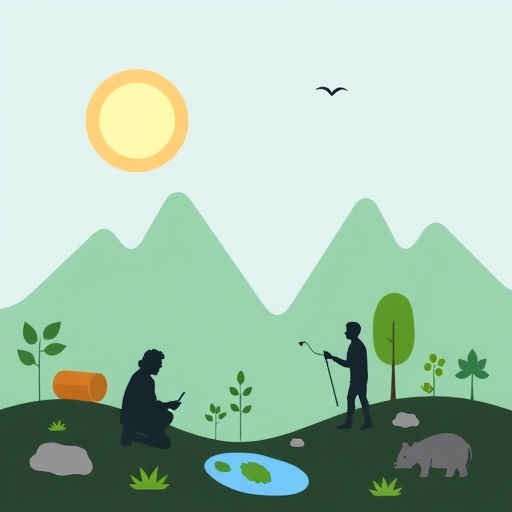In recent years, the integration of environmental education into various educational frameworks has gained significant traction as we confront escalating climate challenges and environmental degradation. A pivotal study by N. Djam’an, published in the journal “Discov Educ,” delves into the implementation of environmental education through the STEAM (Science, Technology, Engineering, Arts, and Mathematics) approach, highlighting its importance for fostering sustainability. This comprehensive examination sheds light on how educators can use innovative pedagogical frameworks to engender a more environmentally conscious generation.
The STEAM approach emphasizes a multidisciplinary framework, urging students to draw connections between scientific principles and artistic expression. Djam’an advocates for the infusion of environmental education within this paradigm, arguing that it not only enhances academic engagement but also equips students with the necessary tools to understand and address environmental issues critically. The underlying premise is that through STEAM, students can cultivate a holistic appreciation of the environment, intertwining creativity with scientific inquiry to solve real-world problems.
One fundamental aspect of the study is the conceptual linkage between environmental education and sustainability. Sustainability is not just a buzzword; it embodies a set of values and practices that aim to meet present needs without compromising the ability of future generations to meet theirs. By integrating environmental education into the STEAM framework, Djam’an posits that educators can foster a culture of sustainability among students. This not only enhances students’ understanding of ecological interdependence but also instills a sense of responsibility towards their communities and the planet.
Furthermore, the research highlights the role of technology within the STEAM approach. In an age dominated by digital innovation, technology serves as a powerful ally in environmental education. Djam’an demonstrates how digital tools, such as interactive simulations and data collection apps, can make abstract environmental concepts tangible and relatable for students. By employing these tools, educators can engage students more effectively, encouraging them to explore ecological data and understand patterns relating to climate change.
The study also addresses the significance of arts in environmental education. Djam’an underscores the capacity of artistic expressions, whether through music, visual arts, or performing arts, to convey complex environmental messages in accessible and emotionally resonant ways. Arts can serve as a catalyst for dialogue and discourse on environmental issues, inviting students to convey their understanding creatively and authentically. This creative engagement not only deepens understanding but also inspires a passion for environmental stewardship, as students connect on a personal level with the subject matter.
Another essential point made by Djam’an is the necessity of practical, hands-on experiences. Students thrive when learning is experiential rather than solely theoretical. Field trips, community service projects, and interaction with local environmental organizations provide invaluable opportunities for students to apply their learning in real-world contexts. As they participate in these activities, students not only gain knowledge but also develop critical thinking and problem-solving skills by tackling genuine environmental challenges in their communities.
The research goes further by examining the potential barriers to implementing environmental education within the STEAM framework. Djam’an identifies challenges such as lack of resources, insufficient teacher training, and rigid curriculum standards that often prioritize standardized testing over innovative, interdisciplinary approaches. By addressing these barriers, educators can create a more conducive environment for teaching environmental education effectively.
Moreover, the study advocates for collaboration among multiple stakeholders, including educational institutions, policymakers, and environmental organizations. When these entities come together to share resources and expertise, they can create comprehensive programs that elevate the status of environmental education within the educational landscape. While curriculum changes may often be slow and meet resistance, a collaborative approach can foster gradual, meaningful integration of sustainability into educational practices.
In addition to collaboration, Djam’an emphasizes the importance of continuous professional development for teachers. For educators to effectively deliver environmental education, they must receive adequate training and resources. Professional development programs should not only cover the theoretical aspects of environmental education but also provide practical strategies and tools that teachers can use in the classroom. This empowerment fosters confidence and equips educators to facilitate engaging, impactful learning experiences.
The potential for the STEAM approach in nurturing environmental citizenry cannot be overstated. By empowering students with knowledge, skills, and values related to sustainability, educators can guide them toward becoming responsible stewards of the planet. Djam’an’s research highlights the importance of fostering a deep connection between students and their environment, ultimately inspiring them to advocate for sustainable practices within their communities.
As our planet faces unprecedented environmental challenges, the role of education in cultivating a sustainable future is paramount. Djam’an’s study not only sheds light on the critical role of environmental education within the STEAM framework but also serves as a call to action for educators worldwide. By embracing a multidisciplinary approach and prioritizing sustainability, we can equip future generations with the awareness and tools needed to navigate the complexities of the 21st century and beyond.
In summary, the intersection of environmental education and the STEAM approach offers a robust framework for addressing pressing ecological issues. N. Djam’an’s work illuminates the multifaceted nature of this endeavor, advocating for a holistic, inclusive, and hands-on approach to education that prioritizes sustainability. It is through such innovative and collaborative educational strategies that we can hope to inspire and empower students to become the environmental leaders of tomorrow.
The exploration of environmental education within the STEAM framework is not merely an academic exercise; it is a necessary step towards a sustainable future. As we look ahead, it is crucial for educational institutions to embrace this transformative approach, recognizing the profound impact it can have on shaping environmentally responsible citizens prepared to tackle the challenges of an ever-changing world.
Subject of Research: Environmental education and STEAM for sustainability
Article Title: Examining the implementation of environmental education in the STEAM approach for sustainability
Article References:
Djam’an, N. Examining the implementation of environmental education in the STEAM approach for sustainability.
Discov Educ 4, 410 (2025). https://doi.org/10.1007/s44217-025-00837-4
Image Credits: AI Generated
DOI: 10.1007/s44217-025-00837-4
Keywords: Environmental education, STEAM, sustainability, education, interdisciplinary learning, climate change, hands-on experiences, creative engagement.




